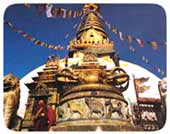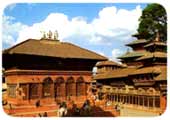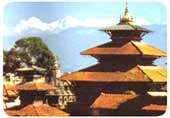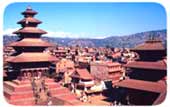|
This tour is made
to have the mix of culture, nature, safari and rafting
adventure. This tour includes the major attractions
of the Kathmandu valley and takes you to the city of
natural beauties and centre of adventure to Pokhara
for 3 days which will take you close to the Annapurna
range and to the Nepal's southern Terai belt for jungle
safari. Pokhara is a place of remarkable natural beauty.
The serenity of Phewa Lake and the magnificence of the
fishtailed summit of Mt. Machhapuchre rising behind
it create an ambience of peace and magic. Clearly the
most stunning of Pokhara's sights is the
spectacular panorama of the Annapurna range which forms
its backdrop. Royal Chitwan National Park, the best
park in Nepal for seeing animals in wild. This national
park boasts of 450 species of birds including four species
of deer, leopard, sloth bear, wild bear and many other
wildlife. This park is well known for one horned Rhinoceros
and it is a shelter for few Royal Bengal Tigers. Besides
this Chitwan also supports a great variety of flora
and fauna.
Day
to Day Itinerary.
Day 01: Arrival in Kathmandu.
Upon arrival at the airport, welcome by our representative
& transfer to the Hotel. At the hotel briefing about
the program by our representative. Rest day at leisure.
Day 02: Sightseeing in Kathmandu Valley.
After breakfast, introduce with the Sightseeing Guide
& driver. We set to the first day sightseeing of
Kathmandu Valley. Today you will see the following spots;
the details are as described below:
Swoyambhunath
 The
four seeing eyes of Swoyambhunath Stupa watch over the
valley from the top of 77-m high hillock on western
side. This most glorious Stupa in the world, is one
of the holiest Buddhist sites in Nepal and its establishment
is linked to the creation of Kathmandu valley out of
a primordial lake. The surroundings of the Swoyambhunath
are covered with small Chaityas & monasteries as
well as some Hindu temples. The National Museum and
the Museum of Natural History are situated at the foot
of the hill. The
four seeing eyes of Swoyambhunath Stupa watch over the
valley from the top of 77-m high hillock on western
side. This most glorious Stupa in the world, is one
of the holiest Buddhist sites in Nepal and its establishment
is linked to the creation of Kathmandu valley out of
a primordial lake. The surroundings of the Swoyambhunath
are covered with small Chaityas & monasteries as
well as some Hindu temples. The National Museum and
the Museum of Natural History are situated at the foot
of the hill.
Kathmandu Durbar Square
 This
complex of palaces, courtyards and temples, built between
12th and 18th Centuries, used to be the seat of ancient
Malla Kings of Kathmandu. It is the place where kings
of Nepal are crowned and their coronations solemnized.
An intriguing piece here is the 17th century stone inscription
set into the wall of the palace with writings in 15
languages. Kumari Temple: Kumari temple is the residence
of the Living Goddess. Kumari, known as Virgin Goddess
has got some specialties, she must be chosen from a
typical Newari cast with no body marks & injuries
& will be replaced by another Kumari after puberty.
Kasthamandap: Kasthamandap is believed to be constructed
from the wood of a single tree in the sixteenth century.
Situated near to the Kumari Temple. The name Kathmandu
was named after this temple. This
complex of palaces, courtyards and temples, built between
12th and 18th Centuries, used to be the seat of ancient
Malla Kings of Kathmandu. It is the place where kings
of Nepal are crowned and their coronations solemnized.
An intriguing piece here is the 17th century stone inscription
set into the wall of the palace with writings in 15
languages. Kumari Temple: Kumari temple is the residence
of the Living Goddess. Kumari, known as Virgin Goddess
has got some specialties, she must be chosen from a
typical Newari cast with no body marks & injuries
& will be replaced by another Kumari after puberty.
Kasthamandap: Kasthamandap is believed to be constructed
from the wood of a single tree in the sixteenth century.
Situated near to the Kumari Temple. The name Kathmandu
was named after this temple.
Patan City:
 Patan
Durbar Square: Patan Durbar Square is an enchanting
mélange of Palace buildings, artistic courtyards
and graceful pagoda temples. Listed as a World Heritage
Site, the former Royal Palace complex is the center
of Patan's religious and social life, and houses a museum
containing an array of bronze statues and religious
monuments. One remarkable monument here is 17th century
temple dedicated to the Hindu god Krishna, built entirely
of stone. Patan
Durbar Square: Patan Durbar Square is an enchanting
mélange of Palace buildings, artistic courtyards
and graceful pagoda temples. Listed as a World Heritage
Site, the former Royal Palace complex is the center
of Patan's religious and social life, and houses a museum
containing an array of bronze statues and religious
monuments. One remarkable monument here is 17th century
temple dedicated to the Hindu god Krishna, built entirely
of stone.
Tibetan Refugee Camp: This
camp was set up in 1960 under the initiative of the
International Red Cross & the Swiss Development
Corporation in corporation with HMG of Nepal. Its main
objective is to help the Tibetan Refugees to do something
nice & support themselves & some carpet industries
& handicrafts have been operating.
Day 03: Drive to Majimtar/rafting-Pokhara.
After breakfast, drive about 3 hours to Majimtar. The
rafting commences from Majimtar for 2 hrs & ends
at Kuringhat. After Lunch raft up to Muglin. Terminate
the rafting & drive to Pokhara three hrs. Pokhara
is the city of adventure. An enchanting city nestled
in a tranquil valley (827 m), it is the starting point
for many of Nepal's most popular trekking & rafting
destination. Pokhara is the second largest city of Nepal.
There serenity of Phewa Lake and the magnificent Mt.
Fishtail rising behind it create an ambience of peace
& magic. At an elevation lower than Kathmandu, it
has much more typical feel to it, a fact well appreciated
by the diversity of flowers, which prosper in its environs.
Indeed, the valley surrounding Pokhara is home to thick
forests, gushing rivers, and emerald lakes and of course,
the world famous views of the Himalaya. The best &
closer views of Annapurna Ranges & Mt. Fishtail
can be seen from here. Pokhara is well connected by
air & land with Kathmandu (200 km far & 30 minutes
flight) as well as by land with other major destinations
of Nepal. The major attractions of Pokhara city are:
Phewa Lake, Barahi Temple, Devin's fall, Bindabasini
Temple, Seti George etc. Overnight at the hotel.
Day 04: Pokhara-Pothana
Drive Pokhara Phedi for 30 minutes. Start trek to Pothana
5 hours.
Day 05: Pothana-Landrung Trek
for 5 hours.
Day 06: Landrung-Birethanti-Pokhara.
Trek Landrung-Birethani for 5 hours and Drive to Pokhara
for 2 hours.
Day 07: Drive Pokhara-Chitwan
National Park.
After breakfast, enjoy a pleasant boat ride in Phewa
Lake reflecting the panoramic views of Mt. Fishtail
on its backdrop. Then drive to Chitwan, about 5-hrs
drive. Upon arrival at the Lodge welcome & briefing
by the naturalist. After Lunch, either canoe or elephant
ride.
Day 08: Chitwan - Kathmandu:
Early in the morning, after/tea coffee; set for the
Jungle walk & bird watching. After breakfast, drive
to Kathmandu. The drive from Chitwan to Kathmandu takes
about 6 hours and the drive passes through the beautiful
valleys, bank of the river and arrives in Kathmandu
via Nag Dhunga pass(1800m).
Day 09: Sightseeing in Kathmandu Valley.
After breakfast set for the another day's sightseeing:
Boudhanath
 This
Stupa lies 6-km downtown Kathmandu. This colossal and
ancient Stupa, one of the biggest in the world, has
the all-seeing eyes of Lord Buddha. It was built in
the fifth century AD. It is built on an octagonal base
inset with prayer wheels. One can observe devotees chanting
religious hymns & playing with prayer wheels. This
Stupa lies 6-km downtown Kathmandu. This colossal and
ancient Stupa, one of the biggest in the world, has
the all-seeing eyes of Lord Buddha. It was built in
the fifth century AD. It is built on an octagonal base
inset with prayer wheels. One can observe devotees chanting
religious hymns & playing with prayer wheels.
Pashupatinath Temple
Situated 5 km east on the bank of sacred
Bagmati River, the temple of Lord Shiva with two-tiered
golden roof and silver doors is famous for its superb
architecture. Chronicles indicate the temple's existence
prior 400 AD. Devotees can be seen taking ritual dips
in the holy Bagmati River
Bhaktapur City:
 Durbar
Square: As you walk in, you can not but be overcome
by a feeling of inner harmony. Such is the art and architecture
and the special layout here. The 15th century Palace
of 55 windows, situated to the left as you enter through
the city gate, inspires admiration. The National Art
Gallery is also situated inside. The Palace Entrance,
Golden Gate that is the entrance to the main courtyard
of the Palace of 55 windows, is masterpiece in repousse
art. In front of the palace building is a medley of
temples of various designs. There are temples like Batsala
Temple and the Shiva temple, the replica of Pashupatinath
Temple etc. Nyatapola Temple: This five story pagoda
was built in 1702 AD. Each story has pair of figures
(two wrestlers, two elephants, two lions, two griffins
and goddess's tigress & lioness). This temple is
one of the tallest pagodas & famous for its massive
structure and subtle workmanship. Durbar
Square: As you walk in, you can not but be overcome
by a feeling of inner harmony. Such is the art and architecture
and the special layout here. The 15th century Palace
of 55 windows, situated to the left as you enter through
the city gate, inspires admiration. The National Art
Gallery is also situated inside. The Palace Entrance,
Golden Gate that is the entrance to the main courtyard
of the Palace of 55 windows, is masterpiece in repousse
art. In front of the palace building is a medley of
temples of various designs. There are temples like Batsala
Temple and the Shiva temple, the replica of Pashupatinath
Temple etc. Nyatapola Temple: This five story pagoda
was built in 1702 AD. Each story has pair of figures
(two wrestlers, two elephants, two lions, two griffins
and goddess's tigress & lioness). This temple is
one of the tallest pagodas & famous for its massive
structure and subtle workmanship.
Day 10: After breakfast transfer
to the airport to fly to onward destination.
|


